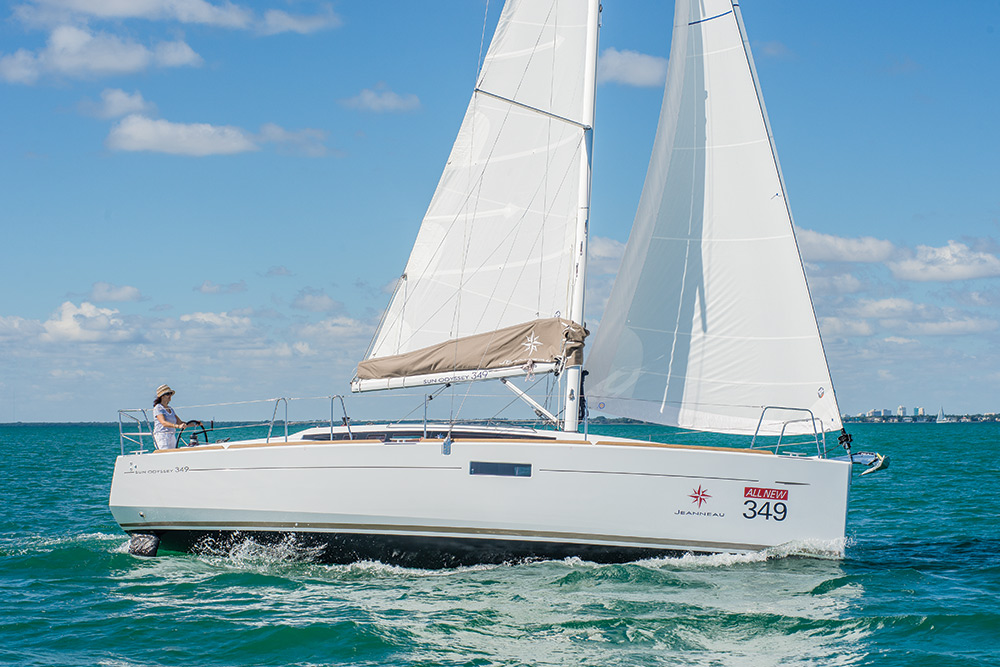Easy does it
The Jeanneau Sun Odyssey 349 packs a big-boat punch with innovative features, a spacious interior and easy-to-sail speed

We test sailed the 349 on Biscayne Bay, sailing in the shadow of Miami’s glittering skyline. The conditions were ideal, with 10- to 15-knot winds from the east, gentle turquoise seas and a perfect 75-degree February day. Yes, I said February. Jeanneau’s product specialist Jeff Jorgensen, a font of knowledge when it comes to all things Jeanneau, and my wife Tadji joined me for the outing. Our test boat was fitted with the standard mainsail, stowed in a lazy bag. A square-topped high-performance main and in-mast furling main are both options, an example of the wide cross section of the sailors the 349 is designed to appeal to. We came into the wind, quickly hoisted the main and unfurled the 106% genoa. Tadji took the helm as we sped south on a close reach at 6.5 knots.

The details
Following the trend of recent Sun Odyssey models, including the 409 and 469, the 349 has a shallow forefoot, a long waterline and wide beam that’s carried all the way aft. By the numbers, the length-overall-to-waterline-length ratio is 97% and the beam-to-length ratio is 2.9. A subtle chine runs aft and is both aesthetically pleasing and practical. It appears to lower the overall freeboard and more importantly, increases form stability and adds volume aft, making the aft cabins more spacious.
Below the waterline, the 349 has two keel options. The standard draft is a 6-foot 5-inch deep fin with and L-shaped sculpted bulb. The shoal-draft model reduces the draft to 4 feet 10 inches. Jeff Jorgensen mentioned that a keel centerboard/swing keel was a possible future option. The displacement is 11,772 pounds, translating into a displacement-to-length ratio of 151 and putting the 349 on the sporty side of moderate. Twin rudders make sense when the beam is carried aft and help keep the boat under control, especially when surfing and conversely when heeled.
Two rigs are offered, the performance rig that includes the square-top main and 33 square feet of additional sail area, and the standard rig with 613 square feet. Both are fractionally rigged with deeply angled double swept spreaders that don’t require a backstay. The spreaders are swept aft at 30 degrees, and while this eliminates the need for a backstay it also limits the range of the mainsail when deep reaching. Of course you can mitigate this problem with a performance reaching sail. There are advantages to keeping the stern clear of standing rigging, and when you combine the lack of a backstay with twin wheels, it really opens up the 349 cockpit, making it feel like a much larger boat. The cockpit, like the hull shape, widens as you move aft, and with the drop-down transom step and swim platform deployed it’s remarkably spacious. Our test boat was fitted with a handsome teak cockpit table with storage in the middle and robust stainless handrails on top. With the two aft cabins and opening transom, lazarette space is limited. There is however a dedicated life raft locker near the stern, the perfect spot should you have to launch it in an emergency.
The sight lines from both helms are uncluttered and it’s quite nice to have the choice of high- and low-side sailing by shuffling from one helm to the other. Sail controls are led aft to both helms through Spinlock clutches. A Harken self-tailing winch mounted just forward of each wheel does the heavy lifting. A Y-bridle mainsheet arrangement takes the place of the traditional traveler, and the genoa headsail leads employ friction rings instead of genoa tracks and cars. Derived from the Sun Fast series, and of course other race boats, I like this “soft” approach to sail control. It allows for great flexibility and balance when it comes to trimming options and is definitely the look of the future as new supercharged Spectra ropes and lightweight alloys continue to take over applications usually reserved for metals. A solid vang is still part of the mainsail control system.
The side decks are wide, easy to navigate, comfortable to lounge on and the molded nonskid is superb, a Jeanneau specialty. Deck hardware is first rate, from cleats to stanchions. An external anchor locker is deep enough to house the second anchor and also the optional windlass. A bowsprit is optional, and ideal for setting a code zero or asymmetrical sail for reaching. This option pushes the anchor roller into an offset position.

Comments